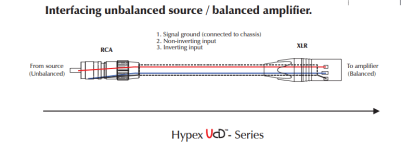There are many discussions on this topic but I am not clear as to which is the correct way of making a SE to Balanced cable. Using two-conductor + shield cable. SE source to Balanced input amp.
It basically boils down to two topologies:
1. Hypex recommends connecting the shield at the SE end;
2. RANE recommends leaving the shield (at the SE end) open.
Which is correct? Is there a difference?
It basically boils down to two topologies:
1. Hypex recommends connecting the shield at the SE end;
2. RANE recommends leaving the shield (at the SE end) open.
Which is correct? Is there a difference?
Attachments
I didn't read Hypex's explanation for their way to wire SE to balanced
but I think Rane has a sound write-up.
It's well worth to consult Ott's book on 'Noise Reduction Techniques in Electronic Systems'.
A bit of experimentation on the specific connections to be made is always worthwhile.
Hugo
but I think Rane has a sound write-up.
It's well worth to consult Ott's book on 'Noise Reduction Techniques in Electronic Systems'.
A bit of experimentation on the specific connections to be made is always worthwhile.
Hugo
I was advised that the shield is connected to the source end only and have done that for decades. If you look at interconnects with arrows on the cable you will find the arrow points away from the source and the shield is connected at that end only.
In RCA’s, a braided shield surrounding the common and signal conductors should only have that shield terminated at the source end. This common connects to signal ground, and ultimately the common output side of the power supply. It does not connect to the chassis directly, typically. In cases where it does, this is done using a small capacitor between the signal ground and chassis right at the RCA jacks.
XLRs (which don’t use a common signal ground and are instead connected from chassis safety ground to chassis safety ground, or sometimes just at one end) can mess up the balanced XLR to single-ended RCA conversion.
This is another facet of the Pin 1 problem.
XLR to RCA requires that the XLR end of the circuit have a connection to the signal ground to complete the circuit, otherwise the common is left floating, but this can be a problem. The shield in Pin 1 was not intended to be used as a signal ground carrier. By connecting Pin 1 to signal ground it can inject noise and even introduce a ground loop. One has to watch where the currents are flowing when chassis’ have different potentials when they connect to signal ground. Sometimes a ground loop breaker (resistance of 10-100 Ohms and some opposed diodes) is used to mitigate a possible ground loop.
Edit: I would connect the shield to the balanced XLR end, as that’s how it was supposed to work. If it’s connected at the RCA end it injects whatever noise is superimposed on that shield to the signal ground.
XLRs (which don’t use a common signal ground and are instead connected from chassis safety ground to chassis safety ground, or sometimes just at one end) can mess up the balanced XLR to single-ended RCA conversion.
This is another facet of the Pin 1 problem.
XLR to RCA requires that the XLR end of the circuit have a connection to the signal ground to complete the circuit, otherwise the common is left floating, but this can be a problem. The shield in Pin 1 was not intended to be used as a signal ground carrier. By connecting Pin 1 to signal ground it can inject noise and even introduce a ground loop. One has to watch where the currents are flowing when chassis’ have different potentials when they connect to signal ground. Sometimes a ground loop breaker (resistance of 10-100 Ohms and some opposed diodes) is used to mitigate a possible ground loop.
Edit: I would connect the shield to the balanced XLR end, as that’s how it was supposed to work. If it’s connected at the RCA end it injects whatever noise is superimposed on that shield to the signal ground.
Last edited:
Now, where you’re converting a single-ended RCA source to balanced XLR inputs, your diagrams show it different than when the source is an XLR. If the cable in those images where reversed and used with an XLR source into a single-ended load, one half of the source would be shorted to signal ground.

